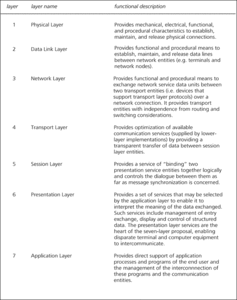The standard model for communications protocols that is formally approved by the International Standards Organization acting in concert with the CCITT. The ISO approach identifies the functionality required in terms of seven separate layers, as summarized in the table; the two systems that are to communicate each support an implementation of these seven layers. The layers are conceptually organized with the ‘lowest’ layer representing the physical link between the two systems, and with successive ‘higher’ layers progressively being concerned less with the details of the network traffic, and more with the details of the end-user applications that wish to communicate. Each local implementation of these layers is often referred to as a protocol stack. Each layer can communicate only with the layers immediately above and below it in the stack. The set of permissible messages and responses in this local ‘vertical’ communication is defined by the corresponding interface. The lowest, physical layer, communicates downward with the physical link, and information passes via the link to the corresponding lowest layer in the remote system. The highest layer communicates upward with the local end-user application.
By passing a message down through the lower layers at the transmitting end, across the link, and up through the layers at the receiving end, each layer can communicate with the corresponding layer in the remote system. The set of permissible messages and responses in this remote, ‘horizontal’ communication is defined by the corresponding protocol. The entire system is therefore defined by the information that can pass vertically via the interface between adjacent layers in a given stack, and horizontally between corresponding layers in the two remote stacks.
The primary objective of the seven-layer model is to provide a flexible means of describing the behaviour of communications systems, capable of dealing with all existing and future technologies, rather than to provide a specific set of protocols and interfaces. The process of reaching international agreements that meet the conflicting requirements of different groups of end-users, accommodate the interests of competing commercial suppliers, and define technically sound products is slow, often taking several years to reach a final set of recommendations. When agreement on proposals has been achieved, the development of commercially viable products conforming to the proposals is again time-consuming. It is then necessary to test the products for conformance, to demonstrate successful interworking between products from different suppliers, and to resolve discrepancies where systems that each separately appear to conform with the proposals do not interwork correctly.
Inevitably during this time, individual users or suppliers will have made their own systems, and in this sense the international standards will always lag behind the ad hoc or proprietary systems. Despite this, the model has itself been used as the basis for networks themselves (X25 for packet networks, ISO 8802.3 for CSMA/CD, ISO 8802.7 for slotted rings, ISO 8802.5 for token rings, ISO 8802.4 for token bus, and X75 for internetwork communication), and for some applications such as email (X400), directory services (X500), and manufacturing automation.

Seven-layer reference model. ISO/OSI model
- protoconch
- Protoctista
- protoderm
- protogalaxy
- protogyny
- protolith
- proton
- proton-adding process
- proton decay
- protonema
- protonephridium
- protonic acid
- proton magnetometer
- proton number
- proton pump
- Proton rocket
- proton–proton reaction
- proto-oncogene
- protoparian suture
- protophloem
- protoplanet
- protoplanetary nebula
- protoplasm
- protoplast
- Protopteridales